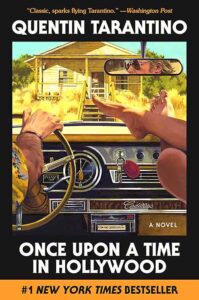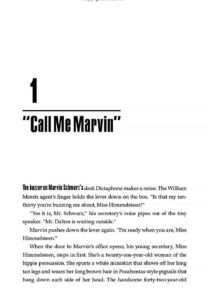By QUENTIN TARANTINO (Harper; 2021)
This, the premiere work of prose fiction by Quentin Tarantino, is in many respects just like his films: unique, unpredictable, outrageous and profane. It’s also, I’m afraid, not entirely satisfying.
ONCE UPON A TIME IN HOLLYWOOD began life as a 2019 movie written and directed by Tarantino. (See trailer below.) This book is a novelization, published in lieu of the screenplay (of which only one copy is said to exist), and very likely taken, at least in part, directly from that screenplay, as would appear to be evident in the present tense prose and rather perfunctory descriptions. It debuted in mass market format (although a “Deluxe Hardcover Edition” is touted on the final page) with very 1970s-centric design, the seventies being the golden age of paperback movie novelizations (as well as Tarantino’s favorite decade).
This particular work, however, takes place in the final year of the 1960s. It was then that the traditional studio system that had ruled Hollywood was being usurped, foreign films were having a renaissance on American screens, hitchhiking was a fad and a certain “family,” led by a failed musician named Charles Manson, was afoot. All those things are covered in these pages, in which fiction is mixed quite audaciously with lengthy dissertations on movies, music and celebrity, and related through a narrative voice that’s nobody’s idea of refined (sample narration: “Rick hates wearing this furry fucking caterpillar stuck to his face”) and chronology that’s anything but linear.
The characters include Rick Dalton, a has-been TV star attempting a comeback of sorts as a heavy in a TV western pilot; Ricki’s equally washed-up stuntman pal Cliff, a war veteran and peacetime murderer (whose victims include his own wife); Trudi Frazer, Rick’s eight year old co-star (who has a MUCH bigger role in the book than she did in the film); the gorgeous blond starlet Sharon Tate and her fabulously successful director hubbie Roman Polanski (who likewise has a much greater role in these pages than he did onscreen); and Pussycat, a (fictional) member of Manson’s family who introduces Cliff into their fold after he picks her up hitchhiking. Tarantino even inserts himself into the action, in a mention of a remake of the Roger Corman production THE LADY IN RED that in this book’s alternate universe was directed by the man himself in 1999, and in a passage near the end in which one Curt Zastoupil, Tarantino’s stepfather, hits up Dalton for an autograph for his son “Quint.”
I would summarize the plot, but there really isn’t one. This is very much a “hang out” narrative, where spending time with the characters takes precedence over the fundamentals of storytelling. As such it’s quite likeable, and even compelling in its own resolutely funky, nontraditional manner.
But as I mentioned above, the novel is not entirely satisfying, especially for those familiar with its screen incarnation. Tarantino appears to have quite deliberately trained his focus on events that weren’t in the film, such as a conversation between Sharon’s hairdresser Jay Sebring and his eccentric butler (whose scenes, cut from the film, were played by Tim Roth), and a good natured rivalry between Rick and Trudi, which, in direct contrast to the happenings of flick, comes to increasingly dominate the novel’s final third.
This brings us to Tarantino’s wildest, and indeed downright perverse, change from film to novel: the jettisoning of the violent ending we saw onscreen, the events of which are dispensed with early on in the text via a perfunctory flash-forward that omits all the details. This is unfortunate, as Tarantino’s take on Susan Atkins (who in the movie gets flambéed in a swimming pool), based on his invigorating characterization of Squeaky Fromme earlier in the book, would doubtless have been interesting. Likewise the antics of Cliff’s dog Brandy, who’s given a far more in-depth accounting here than she was onscreen but is denied the heroic denouement she had therein.
One more complaint I have is with Tarantino’s descriptions of the TV pilot Rick is filming, which are presented as actual occurrences. The idea might have been for these passages to playfully intersect with the “real” action, or possibly they exist as some ironic commentary on the Hollywood milieu in which the action takes place. Either way, though, the effect doesn’t work.



